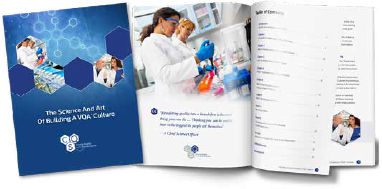Our Quality Approach
Home » Quality Approach
The 4 Pillars of Our Quality Approach

Collaboration Rather Than Confrontation
When quality operates more as a team coach rather than a police officer “enforcing the law,” people better understand and accept their role and responsibility in maintaining quality. Collaboration helps improve compliance performance, which can reduce delays, waste, and redundancy. It is a key factor to ensure value.
It can also help open up an organization to innovative practices. Getting people around a table and facilitating conversations allows everyone to learn and see different perspectives. It also lets people think more broadly and ask the question, “What are we doing as a team to make what we do here better?”
There is more inherent trust and confidence when people work together. Quality departments must foster an environment of openness and information sharing to raise their profile, and levels of confidence and trust among employees.

Proper Education and Training
The cost of educating your workforce is minimal compared to the cost of a product recall and/or putting patient safety at risk.
Training helps ensure that people understand their role and responsibilities within a process and master the required technique(s). Employees can be more engaged and sensitized to quality, so they know their impact and feel valued. And it can make them efficient and more likely to be aware of issues to raise.
Personnel training impacts performance. When employees perform better, there is a reduction in compliance issues. Investing in the proper thinking, approach, and resources is the best way to bulletproof training programs, and to operate in a more proactive “prevention” mode rather than a reactive “inspection” mode. This proactive approach makes your organization nimble and flexible to change and, inevitably, unforeseen issues.
Investments in your team’s education and training are investments in your company.

Setting Proper Expectations
Setting specific and measurable expectations allows people to know what to anticipate, leaving no room for interpretation.
Engaging with employees to set realistic expectations makes them more committed, engaged, and accountable.
Start with a strong list of requirements (as outlined in proper SOPs) that everyone must meet. This can lead to buy-in on how to specifically attain them, helping to shape a process that builds consensus.

Holding People Accountable
Nothing is more empowering than employees feeling responsible for their own work and their own actions. Understanding expectations builds empowerment.
People who are accountable execute with quality. They know what they do matters. They have made a choice to live up to what is expected of them. An organization helps them to be accountable by providing proper training and tools (e.g., SOPs and clear roles and responsibilities).
When personnel know what is expected of them, they take ownership, want to succeed, and have a desire to develop and work within reliable processes and procedures. And when issues arise, they are in a better position to work as a group and focus on finding solutions rather than affixing blame.
Accountability to expectations ensures performance.
